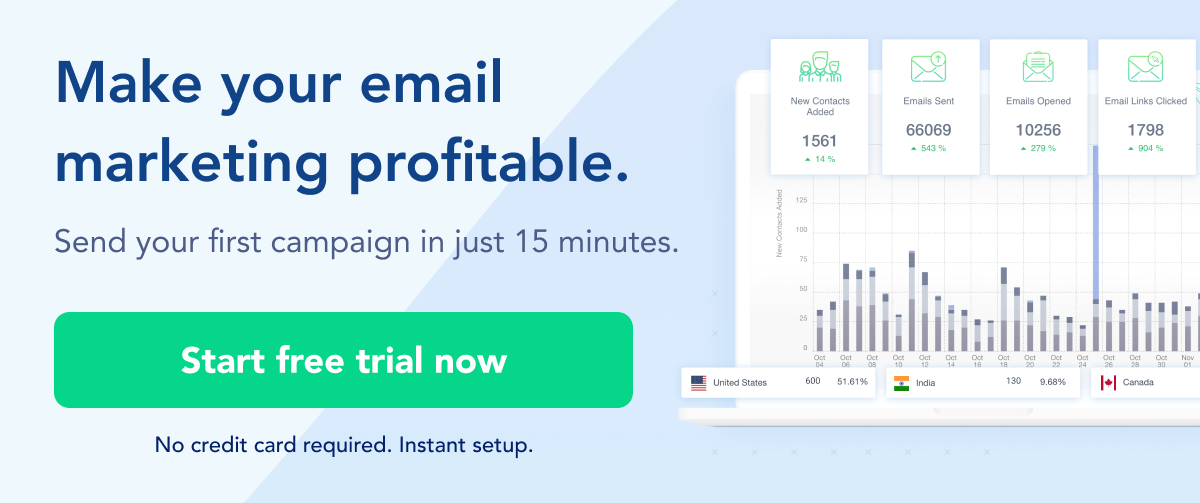Go anywhere these days and you’re bound to see someone on their mobile device. Did you know that 85% of people are checking their email on smartphones?” From chatting with friends to exploring social media feeds, we’re all pretty much glued to our screens. It’s one of the many reasons why mobile optimization of emails is critical if you want to get ahead, or at the very least keep up with the times, in your business.
The simple fact is, more and more people are relying on smartphones and tablets for so many daily tasks. If you’re not shifting your email marketing strategies to account for smaller screens and on-the-go user behavior, well, you could be missing out on countless opportunities for growth.
Below, we’ll explore techniques for crafting responsive and engaging emails tailored to the mobile experience. So, if you want to understand how to optimize your campaign for mobile use, keep reading!
Table of Contents
The Mobile Takeover: Understanding the Changing Landscape
Mobile usage has grown by record numbers in recent years. Nearly seven billion people worldwide now use mobile devices daily. That’s nearly double compared with 2016’s numbers!
In the United States alone, more than 80% of internet usage now occurs on mobile devices. With smartphones and tablets dominating our digital lives, users expect seamless experiences and instant gratification when browsing on mobile. As a result of the growing demand for using mobile devices, your website and emails must adapt to these evolving user behaviors and patterns on mobile. If you don’t adapt, your business could risk losing visibility and engagement.
Crafting a Mobile-Friendly Website: Tips and Best Practices
With mobile dominating traffic, having a responsive and user-friendly website is essential. The question is, how do you go about this? Here are some tips for optimizing your website for mobile users:
- Use responsive web design to automatically adapt layouts for any screen size. Think mobile-first design since more and more users prioritize mobile over desktop for a lot of their internet usage.
- Display important info “above the fold.” This means the information users see immediately without scrolling.
- Use legible font sizes and types (i.e. no cursive or squiggly fonts). You also should use ample line spacing for easier readability.
- Ensure that all buttons and links have touch-friendly sizes, and simplify navigation menus for quick access on the go.
- Finally, check site speed on mobile.
Bottom line - Every aspect of your site should cater to “thumb-friendly navigation,” and quick mobile experiences.
The Need for Speed: Optimizing Page Load Times for Mobile
We touched on it in the previous section, but it’s so important we’re going to dive into mobile speed a little further.
Just how important is speed? Most website speed reports recommend that your website load in two seconds. Your load time needs to be quick or your visitor will “bounce.” Bounce rate refers to how many people leave your website after attempting to engage with it, and higher bounce rates negatively impact your search engine ranking because it tells search engines you aren’t giving users what they want.
Why will they bounce? Sluggish load times frustrate users on mobile. With slower networks and minimal patience, quick page loads are vital.
How can you speed up your website load time? Here are a few ideas that might help:
Enable compression and caching to minimize file sizes. The biggest thing that bogs down mobile website response time is images, so it’s best to optimize and compress images before uploading. Alternatively, you could also use web design plugins that reduce image sizes for you to speed up your website’s load time.
It’s also a good idea to “minify CSS” and JavaScript files. This will remove whitespace and optimize common programming patterns on a website. While you’re at it, remove unnecessary widgets and plugins that slow things down.
How fast is your website load time? Test your site’s mobile speed using a tool like Google PageSpeed, GTmetrix or WebPageTest to find out.
Crafting Compelling Mobile Content
With short attention spans on mobile, your content must cater to on-the-go users who skim and scan. For example, it’s best to use succinct sentences and paragraphs for scannability.
Focus on readability with bullet points, numbered lists and clear formatting as well. A few additional tips include:
- Optimizing typography, line length and font sizes for the small screen
- Incorporating engaging graphics, infographics and videos
- Writing strong headlines and subheads that grab attention, and
- Linking to additional resources for those interested in learning more
Bonus points if the additional resources are on your own website as this can increase a user’s time on your site!
Wait! What Does This Have to Do With Email?
Now, you might be wondering - We’re close to the halfway mark of this article, and we’ve not yet said anything about the emails themselves. What does all of this have to do with mobile optimization of emails?
You raise a good point, and at first glance, having a mobile-friendly website may seem unrelated to optimizing emails for mobile. But there are some critical connections between the two.
Directing traffic
For starters, emails often direct recipients to landing pages on a company's website. Those pages should be fast-loading and mobile-friendly to continue user engagement.
Consistent brand experience
Users expect a seamless experience with your brand across channels and devices. A mobile-optimized website and emails demonstrate you understand mobile users.
Reinforcing key messages
Your website can reinforce the messages and calls-to-action from your email campaigns. This helps users take action when arriving from an email.
Shared design elements
A mobile-first website can share design elements and components with mobile-optimized emails to maintain a cohesive look and feel.
Mobile analytics
Having a mobile site helps gather data on user behavior which can inform strategies for mobile emails as well.
Competitive advantage
Brands that have mobile-friendly websites and emails demonstrate technical savvy and understanding of mobile users compared to those who don't.
While a mobile website and mobile emails have distinct purposes, optimizing both contributes to a unified mobile strategy that delivers consistent and compelling mobile experiences. Taking a mobile-first approach to your website and emails allows seamless user engagement across all touchpoints.
Optimizing Your Site for Mobile: SEO Perks
Google favors mobile-friendly sites, so here are a few best practices to consider:
- Use responsive design and fast loading pages
- Target local SEO opportunities with location-based keywords
- Identify high-value mobile keywords based on search intent
- Ensure clutter-free layouts and navigation for small screens
- Adapt page titles and meta descriptions for mobile users
App Optimization Strategies for User Acquisition
For some businesses, developing a branded mobile app can provide value. You’ll need to optimize the app experience to drive downloads and usage. Useful app optimization tactics include:
- Research keywords to target in the app store listings
- Craft compelling text, screenshots and videos on the app store page
- Make the app interface intuitive with thoughtful information architecture
- Provide a seamless user experience that retains customers
- Monitor reviews and keep improving the app with user feedback
- Leverage mobile attribution to understand which channels and campaigns drive the most users
With solid app store optimization (ASO) and user-centric design, your app can engage customers on mobile.
Leveraging Mobile Advertising to Reach Users
With proliferating mobile usage, advertising on mobile platforms allows you to engage potential customers. Consider these tips for effective mobile ads:
- Create ads optimized for different placements like social media, search, and in-app.
- Tailor creatives, messaging and calls-to-action for mobile.
- Target ads contextually to location, demographics, intent and interests.
- Set up A/B testing for different elements like design, copy, etc.
- Analyze performance data like clicks, conversions and ROI.
Strategic mobile advertising placements with relevant targeting and testing will get your brand seen by your audience.
Optimizing for Seamless Mobile User Experiences
Beyond pure functionality, optimizing the user experience and journey is crucial for mobile engagement. This means simplifying navigation and menus for easy access to key pages. You may also want to consider the implementation of thumb-friendly tap targets and swipe gestures for natural interaction.
It’s best to minimize friction and avoid the navigation of countless forms for seamless buying journeys. While you’re at it, test your website and buying experience across different devices to identify pain points or bugs. Be sure to listen to feedback and reviews to keep enhancing mobile UX as well.
Leveraging Mobile Social Media
With high mobile social media usage, incorporating social into your marketing strategy can be impactful. To help with this, it’s best to optimize social content for mobile by using compelling visuals and videos.
Make posts and ads interactive and shoppable to boost engagement as well. It may also be beneficial to use geo targeting capabilities on social platforms to personalize regionally.
The Future is Mobile: Key Takeaways
Mobile has fundamentally transformed how we interact online. With mobile adoption continuing to grow globally, having a robust mobile strategy is no longer optional for businesses - it's imperative.
With the tips covered in this guide, you can craft seamless mobile experiences that cater to ever-evolving user expectations and behaviors. While mobile optimization may seem daunting, taking it step-by-step and keeping the end-user in mind will lead to mobile success.
Tools like SendX can streamline mobile optimization of emails with responsive templates, dynamic content, previews and detailed analytics. Its mobile-first email builder gives you the power to easily create targeted campaigns tailored for smartphones and tablets.
The effort is well worth it - with mobile poised to only grow further, having a robust mobile presence will be a key competitive advantage for any modern business.
Embrace the mobile revolution by implementing these strategies today. As your customers increasingly turn to their mobile devices, you'll be ready to engage them wherever they are. Being mobile-friendly is no longer optional - it's the new standard. Take the steps now to thrive in this fast-evolving mobile age.



